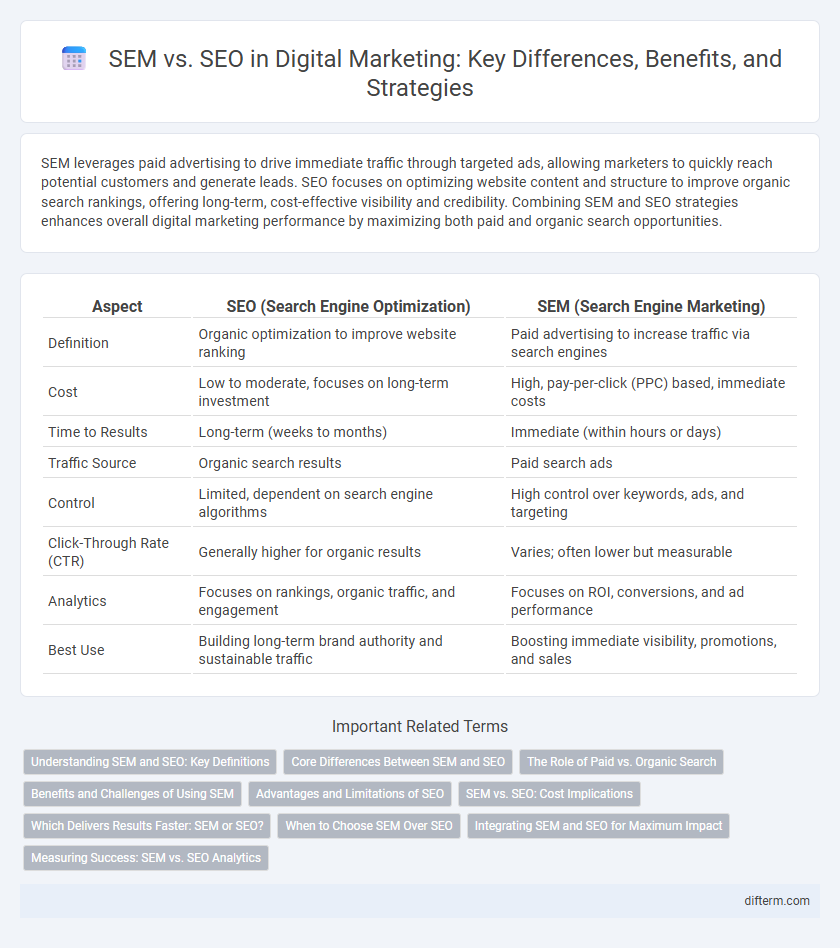SEM leverages paid advertising to drive immediate traffic through targeted ads, allowing marketers to quickly reach potential customers and generate leads. SEO focuses on optimizing website content and structure to improve organic search rankings, offering long-term, cost-effective visibility and credibility. Combining SEM and SEO strategies enhances overall digital marketing performance by maximizing both paid and organic search opportunities.
Table of Comparison
| Aspect | SEO (Search Engine Optimization) | SEM (Search Engine Marketing) |
|---|---|---|
| Definition | Organic optimization to improve website ranking | Paid advertising to increase traffic via search engines |
| Cost | Low to moderate, focuses on long-term investment | High, pay-per-click (PPC) based, immediate costs |
| Time to Results | Long-term (weeks to months) | Immediate (within hours or days) |
| Traffic Source | Organic search results | Paid search ads |
| Control | Limited, dependent on search engine algorithms | High control over keywords, ads, and targeting |
| Click-Through Rate (CTR) | Generally higher for organic results | Varies; often lower but measurable |
| Analytics | Focuses on rankings, organic traffic, and engagement | Focuses on ROI, conversions, and ad performance |
| Best Use | Building long-term brand authority and sustainable traffic | Boosting immediate visibility, promotions, and sales |
Understanding SEM and SEO: Key Definitions
Search Engine Marketing (SEM) involves paid advertising efforts such as pay-per-click (PPC) campaigns to increase website visibility on search engines, while Search Engine Optimization (SEO) focuses on organic strategies to improve website ranking through keyword optimization, quality content, and technical improvements. SEM delivers immediate results by targeting specific keywords via ads, whereas SEO builds long-term authority and traffic through consistent content and backlink development. Both SEM and SEO are essential components of a comprehensive digital marketing strategy aimed at enhancing online presence and driving qualified traffic.
Core Differences Between SEM and SEO
Search Engine Marketing (SEM) primarily involves paid advertising strategies like Pay-Per-Click (PPC) campaigns to generate immediate traffic, whereas Search Engine Optimization (SEO) focuses on organic methods such as keyword optimization and link building to improve long-term search rankings. SEM delivers faster visibility through targeted ads on platforms like Google Ads, while SEO requires ongoing efforts to enhance website relevance and authority for natural search results. The core difference lies in SEM's use of paid placements versus SEO's emphasis on unpaid, organic search growth.
The Role of Paid vs. Organic Search
Paid search (SEM) provides immediate visibility on search engine results pages through targeted ads while allowing precise budget control and performance tracking. Organic search (SEO) builds long-term authority and trust by optimizing website content and structure to rank naturally, driving sustainable traffic without direct costs per click. Effective marketing strategies integrate both SEM and SEO to maximize reach, combining quick wins from paid campaigns with lasting benefits from organic rankings.
Benefits and Challenges of Using SEM
Search Engine Marketing (SEM) offers immediate visibility and targeted traffic through paid advertising, enabling quick campaign adjustments and precise audience targeting. Challenges include higher costs compared to SEO and the need for continuous management to maintain ad performance and budget efficiency. While SEM delivers fast results, reliance on paid placements means traffic ceases once the budget ends, requiring constant investment for sustained impact.
Advantages and Limitations of SEO
SEO enhances organic website traffic by improving search engine rankings through keyword optimization, quality content, and backlink strategies, leading to sustainable long-term growth. It offers cost efficiency compared to SEM, as there are no direct costs per click, but results require significant time investment and ongoing efforts to maintain rankings. Limitations include dependency on search engine algorithm changes, high competition for top keywords, and slower ROI compared to paid advertising campaigns.
SEM vs. SEO: Cost Implications
Search Engine Marketing (SEM) typically requires a higher upfront investment due to pay-per-click (PPC) advertising costs, enabling immediate visibility on search engine results pages. In contrast, Search Engine Optimization (SEO) demands ongoing efforts in content creation and technical improvements, providing long-term organic traffic without direct ad spend. Businesses must balance SEM's rapid lead generation with SEO's sustainable, cost-effective growth strategy for optimal marketing budgets.
Which Delivers Results Faster: SEM or SEO?
SEM delivers faster results than SEO by leveraging paid ads that appear immediately in search engine results pages, driving instant traffic and conversions. SEO requires ongoing optimization of website content, backlinks, and technical elements to build organic rankings over weeks or months, making it a longer-term strategy. Businesses seeking rapid visibility and immediate leads often prioritize SEM campaigns while integrating SEO for sustainable growth.
When to Choose SEM Over SEO
Choose SEM over SEO when immediate visibility and traffic are critical, as SEM delivers faster results through paid ads while SEO requires time for organic ranking improvements. SEM provides precise targeting options, allowing marketers to reach specific demographics, locations, and user intents with paid search campaigns. In highly competitive markets or during product launches, SEM ensures a strong presence on search engine results pages, maximizing exposure and conversions swiftly.
Integrating SEM and SEO for Maximum Impact
Integrating SEO and SEM strategies creates a comprehensive digital marketing approach that maximizes visibility and drives targeted traffic to websites. SEO provides sustainable, long-term organic growth by optimizing content and site structure for search engines, while SEM delivers immediate results through paid advertisements targeting specific keywords and demographics. Combining these methods allows marketers to capitalize on data insights from paid campaigns to refine organic efforts, enhancing overall performance and return on investment.
Measuring Success: SEM vs. SEO Analytics
SEM success is measured through real-time metrics such as click-through rates (CTR), cost per acquisition (CPA), and immediate conversion tracking via platforms like Google Ads. SEO analytics focus on organic search performance indicators including keyword rankings, organic traffic growth, bounce rates, and long-term improvements in domain authority using tools like Google Analytics and SEMrush. Understanding these distinct measurement frameworks helps marketers allocate budgets effectively and optimize strategies for sustainable search visibility.
SEM vs SEO Infographic

 difterm.com
difterm.com